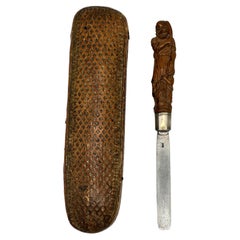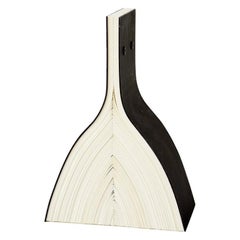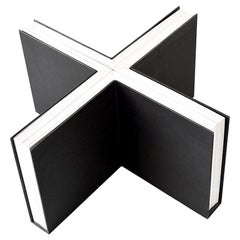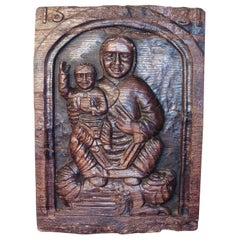Middle East - Sculptures and Carvings
to
1,160
782
2
1
2
1
2
3
3
1
1
1
2
2
2
1
3
1
3
Item Ships From: Middle East
Very Rare 17th century Italian Judaica wood silver Circumcision Knife
Located in Tel Aviv - Jaffa, IL
Here we have this important and very rare example of early Judaica, made in Italy or south Germany, this Circumcision Knife is made from iron, has the guild mark on the blade as used...
Category
17th Century European Antique Middle East - Sculptures and Carvings
Materials
Silver, Iron
Cover #2 by Neil Nenner and Avihai Mizrahi
Located in Geneve, CH
Cover #2 by Neil Nenner and Avihai Mizrahi
Cover Story
Dimensions: H 39.5 x L 15.5 x W 26 cm
Materials: iron
Avihai Mizrahi (b. 1979, Jerusalem)...
Category
2010s Israeli Modern Middle East - Sculptures and Carvings
Materials
Iron
$5,271 / item
Cover #13 by Neil Nenner and Avihai Mizrahi
Located in Geneve, CH
Cover #13 by Neil Nenner and Avihai Mizrahi
Cover Story
Dimensions: H 24.5 x L 49 x W 49 cm
Materials: iron
Avihai Mizrahi (b. 1979, Jerusalem),...
Category
2010s Israeli Modern Middle East - Sculptures and Carvings
Materials
Iron
$5,271 / item
Related Items
'Rat Dog' Sculpture in Fiberglass by Finn Stone
By Finn Stone
Located in Little Burstead, Essex
We love this piece! Number 2 from an edition of 2, the other was sold recently on Saatchi online, and honestly we don't mind rat dog hanging around, he eats no...
Category
2010s English Modern Middle East - Sculptures and Carvings
Materials
Fiberglass
17th Century Primitive Religious Carving Oak Panel 1631
Located in Godshill, Isle of Wight
Primitive religious carving oak panel 1631
This rare piece comes from France, the somewhat Primitive carving shows the Madonna and Child sitting on the Devil who is depicted as a li...
Category
17th Century Medieval Antique Middle East - Sculptures and Carvings
Materials
Oak
17th Century, Peruvian Huamanga Stone
Located in Mexico City, MX
It is a beautiful carved stone known as Huamanga stone, endemic of the Zone of Ayacucho, Viceroyalty of Peru. With a refined regional touch and loaded of pre-Columbian flavor as Chinese, It represents the Holy Family of Mary, Joseph and Jesus with God Father...
Category
17th Century Peruvian Antique Middle East - Sculptures and Carvings
Materials
Stone
Incanto Bust by Raffaello Romanelli
By Raffaello Romanelli
Located in Milan, IT
A glorious work of art by sculptor Raffaello Romanelli, this piece is an original and singular sculpture handcrafted of gypsum. It depicts the bust of a naked female...
Category
2010s Italian Middle East - Sculptures and Carvings
Materials
Plaster
Memento Mori in Wood with Chrismon, Monogram of Christ, Italy End of 17th Cent
Located in Milan, IT
A Memento Mori in wood with Chrismon, monogram of Christ. Valuable sculpture in fruit wood in almost true-to-life measurements, sculpted with art and finished with a wealth of details. The wood was covered with a thin layer of pellet and finished in color.
Immediately above the forehead, in correspondence with the anterior neonatal fontanel, the CHRISMON is painted in purple red. The monogram of Christ or Chi Rho (or CHRISMON) is a combination of letters from the Greek alphabet, which form an abbreviation of the name of Christ. Solar in nature, often inscribed in a circle with multiple rays reminiscent of the cosmic wheel deriving from the ancient solar emblems of Egypt. The symbol consists of two large overlapping letters, the 'X' and the 'P'. They correspond, respectively, to the Greek letter '?' ('chi', which reads kh, aspirated) and '?' ('rho', which reads r). These two letters are the initials of the word '???st??' (Khristòs ), the name of Jesus, which in Greek means "anointed" and translates the Hebrew "messiah". On the sides of these two letters, there are very often two others: one 'a' and one '?', alpha and omega...
Category
Late 17th Century Italian Antique Middle East - Sculptures and Carvings
Materials
Wood
$4,193
H 5.5 in W 5.5 in D 7 in
Pair of Late 16th-Early 17th Century Pinnacle Fragments
Located in Round Top, TX
A very handsome pair of late 16th-early 17th century Pinnacle fragments in polychromed wood. Wonderful architectural elements as they are or perfectly suited to convert into lamps. T...
Category
17th Century Spanish Antique Middle East - Sculptures and Carvings
Materials
Wood
Late 17th/Early 18th C. Carved Wood Hunting Panel C.1680-1750
Located in San Francisco, CA
A late 17th/early 18th century Flemish or Dutch
carved wood panel, possibly from a wall paneling, or a component of a
large cabinet, likely from a hunting lodge.
Category
Late 17th Century Rustic Antique Middle East - Sculptures and Carvings
Materials
Wood
$950 Sale Price
49% Off
H 38.75 in W 51.25 in D 1.25 in
Found and Salvaged Steel House Structure, Modern and Minimalist Sculpture
By Jim Rose
Located in Chicago, IL
Jim Rose, known primarily for his steel furniture, was an avid collector and scoured salvage yards for unique and interesting items. Here, a collection of found steel is reworked, pr...
Category
2010s American Folk Art Middle East - Sculptures and Carvings
Materials
Metal, Steel
$1,500
H 6 in W 9.25 in D 2 in
Found and Salvaged Steel House Structure, Modern and Minimalist Sculpture
By Jim Rose
Located in Chicago, IL
Jim Rose, known primarily for his steel furniture, was an avid collector and scoured salvage yards for unique and interesting items. Here, a collection of found steel is reworked, pr...
Category
2010s American Folk Art Middle East - Sculptures and Carvings
Materials
Metal, Steel
$1,500
H 5.5 in W 7.75 in D 1.75 in
18th/19th Century Italian Baroque Silvered Metal Altar Monstrance Reliquary
Located in Forney, TX
A stunning antique Italian Baroque style silvered metal gilded wood monstrance reliquary. circa 1770-1820
Handmade in Italy in the late 18th / early 19th century, commissioned by the church to display an important religious relic, sculptural painted wood form, mounted with decorative silver repousse metal facing, open oval window where the philatory relic was once housed, rising on a gold gilt painted shaped plinth base.
Dimensions: (approx)
17" High, 8" Wide, 5" Deep, 1.25lbs
History:
Reliquaries (also referred to as a shrine or châsse in French), are containers used to protect and display relics. A portable reliquary may be called a fereter, and a chapel in which it is housed a feretory. A monstrance, also known as an ostensorium (or an ostensory), is a vessel used in Roman Catholic, Old Catholic, High Church Lutheran and Anglican churches for the display on an altar of some object of piety, such as the consecrated Eucharistic host during Eucharistic adoration or Benediction of the Blessed Sacrament. It is also used as reliquary for the public display of relics of some saints.
The use of reliquaries became an important part of Christian practices from at least the 4th century, initially in the Eastern Churches, which adopted the practice of moving and dividing the bodies of saints much earlier than the West, probably in part because the new capital of Constantinople, unlike Rome, lacked buried saints. Relics are venerated in the Oriental Orthodox, Eastern Orthodox, Roman Catholic and some Anglican Churches. Reliquaries provide a means of protecting and displaying relics. While frequently taking the form of caskets, they range in size from simple pendants or rings to very elaborate ossuaries.
The relics were enshrined in containers crafted of or covered with gold, silver, gems, and enamel. These objects constituted a important form of artistic production across Europe and Byzantium throughout the Middle Ages.
Many were designed with portability in mind, often being exhibited in public or carried in procession on the saint's feast day or on other holy days. Pilgrimages often centered on the veneration of relics. The faithful often venerate relics by bowing before the reliquary or kissing it; those churches which observe the veneration of relics distinguish between the honor given to the saints and the worship that is due to God alone.
Sixteenth-century reformers such as Martin Luther opposed the use of relics since many had no proof of historical authenticity and objected to a cult of saints. Many reliquaries, particularly in northern Europe, were destroyed by Calvinists or Calvinist sympathizers during the Reformation...
Category
Early 19th Century Italian Baroque Antique Middle East - Sculptures and Carvings
Materials
Metal
$2,250
H 17 in W 8 in D 5 in
Medusa Low Relief by Romanelli
By Raffaello Romanelli
Located in Milan, IT
An extraordinary work of art by Romanelli sculptors, this low relief is inspired by the celebrated Medusa Rondanini, a Hellenistic marble copy of the ...
Category
2010s Italian Middle East - Sculptures and Carvings
Materials
Plaster
18th-19th Century Italian Wood Carved Angel
Located in San Francisco, CA
A lovely angel, his right hand extended as if to touch something or hold
something. He appears very calm and peaceful, clothed in a partial shroud
which is draped over his shoulder...
Category
Late 18th Century Italian Baroque Antique Middle East - Sculptures and Carvings
Materials
Wood
Recently Viewed
View AllMore Ways To Browse
Terra Cotta Elephant
Terracotta Orientalist
Thomasville French Provincial
Thorn Glass Clear
Threshold Guardian
Tiffany Elsa Peretti Glass
Tiffany Florentine
Tiffany Opalescent Glass
Tiffany Shaker
Tiffany Silver Tea Pot
Tiffany Sterling Silver Cheese
Tiffany Tea Pot
Tiffany Trinket
Tiffany Trumpet Vase
Tiger Bone
Tiki Sculpture
Tin Soldiers
Tool Bag Vintage




